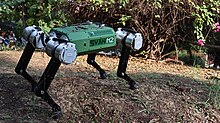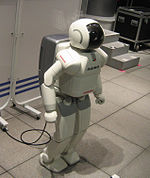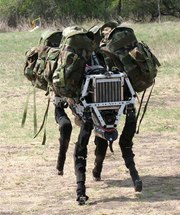Legged robot

Legged robots are a type of mobile robot which use articulated limbs, such as leg mechanisms, to provide locomotion. They are more versatile than wheeled robots and can traverse many different terrains, though these advantages require increased complexity and power consumption. Legged robots often imitate legged animals, such as humans or insects, in an example of biomimicry.[1] [2]
Gait and support pattern
[edit]Legged robots, or walking machines, are designed for locomotion on rough terrain and require control of leg actuators to maintain balance, sensors to determine foot placement and planning algorithms to determine the direction and speed of movement.[3][4] The periodic contact of the legs of the robot with the ground is called the gait of the walker.
In order to maintain locomotion the center of gravity of the walker must be supported either statically or dynamically. Static support is provided by ensuring the center of gravity is within the support pattern formed by legs in contact with the ground. Dynamic support is provided by keeping the trajectory of the center of gravity located so that it can be repositioned by forces from one or more of its legs.[5]
Types
[edit]Legged robots can be categorized by the number of limbs they use, which determines gaits available. Many-legged robots tend to be more stable, while fewer legs lends itself to greater maneuverability.
One-legged
[edit]One-legged, or pogo stick robots use a hopping motion for navigation. In the 1980s, Carnegie Mellon University developed a one-legged robot to study balance.[6] Berkeley's SALTO is another example.[7][8][9][10]
Two-legged
[edit]
Bipedal or two-legged robots exhibit bipedal motion. As such, they face two primary problems:
- stability control, which refers to a robot's balance, and
- motion control, which refers to a robot's ability to move.
Stability control is particularly difficult for bipedal systems, which must maintain balance in the forward-backward direction even at rest.[1] Some robots, especially toys, solve this problem with large feet, which provide greater stability while reducing mobility. Alternatively, more advanced systems use sensors such as accelerometers or gyroscopes to provide dynamic feedback in a fashion that approximates a human being's balance.[1] Such sensors are also employed for motion control and walking. The complexity of these tasks lends itself to machine learning.[2]
Simple bipedal motion can be approximated by a rolling polygon where the length of each side matches that of a single step. As the step length grows shorter, the number of sides increases and the motion approaches that of a circle. This connects bipedal motion to wheeled motion as a limit of stride length.[2]
Two-legged robots include:
- Boston Dynamics' Atlas
- Toy robots such as QRIO and ASIMO.
- NASA's Valkyrie robot, intended to aid humans on Mars.[11]
- The ping-pong playing TOPIO robot.
Four-legged
[edit]
Quadrupedal or four-legged robots exhibit quadrupedal motion. They benefit from increased stability over bipedal robots, especially during movement. At slow speeds, a quadrupedal robot may move only one leg at a time, ensuring a stable tripod. Four-legged robots also benefit from a lower center of gravity than two-legged systems.[1]
Four legged robots include:
- The TITAN series, developed since the 1980s by the Hirose-Yoneda Laboratory.[1]
- The dynamically stable BigDog, developed in 2005 by Boston Dynamics, NASA's Jet Propulsion Laboratory, and the Harvard University Concord Field Station.[12]
- BigDog's successor, the LS3.
- Spot by Boston Dynamics
- ANYmal and ANYmal X (the explosion-proof version) by ANYbotics[13]
- MIT's new back flipping mini Cheetah robot
- Aliengo[14] by Unitree Robotics
- Stanford Pupper[15]
- The Open Dynamic Robot Initiative robots with 8DOF and 12DOF [16] [17]
- Botcat-robot with a moving spine [18] [19]
- Cheetah-Cub robot from the Biorobotics Laboratory [20][21]
- Oncilla robot from the Biorobotics Laboratory(open source) [22] [23]
- Morti robot from the Dynamic Locomotion Group [24] [25]
- Honey Badger by MAB Robotics[26]
- Svan M2 by xTerra Robotics[27]
Six-legged
[edit]Six-legged robots, or hexapods, are motivated by a desire for even greater stability than bipedal or quadrupedal robots. Their final designs often mimic the mechanics of insects, and their gaits may be categorized similarly. These include:
- Wave gait: the slowest gait, in which pairs of legs move in a "wave" from the back to the front.
- Tripod gait: a slightly faster step, in which three legs move at once. The remaining three legs provide a stable tripod for the robot.[1]
Six-legged robots include:
- LAURON, a six-legged, biologically inspired robot being developed at the FZI Forschungszentrum Informatik in Germany.
- Odex, a 375-pound hexapod developed by Odetics in the 1980s. Odex distinguished itself with its onboard computers, which controlled each leg.[6]
- Genghis, one of the earliest autonomous six-legged robots, was developed at MIT by Rodney Brooks in the 1980s.[1][28]
- The modern toy series, Hexbug.
Eight-legged
[edit]Eight-legged legged robots are inspired by spiders and other arachnids, as well as some underwater walkers. They offer by far the greatest stability, which enabled some early successes with legged robots.[1]
Eight-legged robots include:
- Dante, a Carnegie Mellon University project designed to explore Mount Erebus.[1]
- The T8X, a commercially available robot designed to emulate a spider's appearance and movements.[29]
Hybrids
[edit]Some robots use a combination of legs and wheels. This grants a machine the speed and energy efficiency of wheeled locomotion as well as the mobility of legged navigation. Boston Dynamics' Handle, a bipedal robot with wheels on both legs, is one example.[30]
See also
[edit]- Boston Dynamics
- Humanoid robot
- Jansen's linkage
- Klann linkage
- Leg mechanism
- Mecha
- Robot locomotion
- Walking vehicle
- Whegs
References
[edit]- ^ a b c d e f g h i Bekey, George A. (2005). Autonomous robots: from biological inspiration to implementation and control. Cambridge, Massachusetts: MIT Press. ISBN 978-0-262-02578-2.
- ^ a b c Wang, Lingfeng.; Tan, K. C.; Chew, Chee Meng. (2006). Evolutionary robotics: from algorithms to implementations. Hackensack, N.J.: World Scientific Pub. ISBN 978-981-256-870-0.
- ^ S. M. Song and K. J. Waldron, Machines that Walk: The Adaptive Suspension Vehicle, The MIT Press, 327 pp
- ^ J. Michael McCarthy (March 2019). Kinematic Synthesis of Mechanisms: a project based approach. MDA Press.
- ^ M. H. Raibert, Legged Robots That Balance. Cambridge, MA: MIT Press, 1986.
- ^ a b Britton, Peter (September 1984). "Engineering the new breed of walking machines". Popular Science. Vol. 225, no. 3. pp. 67–69.
- ^ Israel, Brett (2016-12-06). "Wall-jumping robot is most vertically agile ever built". Berkeley News. Retrieved 2017-06-07.
- ^ Jason Falconer. "Two-part “stutter jumps" could reduce jumping robot power consumption". 2012.
- ^ Byron Spice. "BowGo! CMU robotics researchers develop a pogo stick that aims high". 2001.
- ^ Liv. "Explosive Pogo Stick Robot Leaps Over 25-Foot Obstacles" Archived 2011-08-06 at the Wayback Machine 2009
- ^ Subbaraman, Nidhi. 2013. "'Hero' Humanoid Valkyrie Is NASA's Newest Biped Robot." Archived 2018-03-22 at the Wayback Machine NBC News. December 11.
- ^ "BigDog - The Most Advanced Rough-Terrain Robot on Earth". Boston Dynamics. Archived from the original on 2017-05-18. Retrieved 2017-06-07.
- ^ "ANYbotics | Autonomous Legged Robots for Industrial Inspection". ANYbotics.
- ^ Chen, Zhongkai. "unitree". unitree.
- ^ "Pupper — Stanford Student Robotics". Stanford Student Robotics.
- ^ "Open Dynamic Robot Initiative". open-dynamic-robot-initiative.github.io.
- ^ Grimminger, F., Meduri, A., Khadiv, M., Viereck, J., Wüthrich, M., Naveau, M., Berenz, V., Heim, S., Widmaier, F., Flayols, T., Fiene, J., Badri-Spröwitz, A., & Righetti, L. (2020). An Open Torque-Controlled Modular Robot Architecture for Legged Locomotion Research. IEEE Robotics and Automation Letters, 5(2), 3650–3657. https://doi.org/10.1109/LRA.2020.2976639
- ^ "Bobcat robot". Bobcat robot, Biorobotics Laboratory EPFL.
- ^ Khoramshahi, M., Spröwitz, A., Tuleu, A., Ahmadabadi, M. N., & Ijspeert, A. (2013). Benefits of an Active Spine Supported Bounding Locomotion With a Small Compliant Quadruped Robot. Proceedings of 2013 IEEE International Conference on Robotics and Automation, 3329--3334. https://doi.org/10.1109/ICRA.2013.6631041
- ^ "Cheetah-Cub – a compliant quadruped robot". Cheetah-cub, Biorobotics Laboratory EPFL.
- ^ Spröwitz, A., Tuleu, A., Vespignani, M., Ajallooeian, M., Badri, E., & Ijspeert, A. (2013). Towards Dynamic Trot Gait Locomotion: Design, Control and Experiments with Cheetah-cub, a Compliant Quadruped Robot. International Journal of Robotics Research, 32(8), 932–950. https://doi.org/10.1177/0278364913489205
- ^ "Oncilla quadruped robot". Oncilla robot, Biorobotics Laboratory EPFL.
- ^ Spröwitz, A. T., Tuleu, A., Ajallooeian, M., Vespignani, M., Möckel, R., Eckert, P., D’Haene, M., Degrave, J., Nordmann, A., Schrauwen, B., Steil, J., & Ijspeert, A. J. (2018). Oncilla Robot: A Versatile Open-Source Quadruped Research Robot With Compliant Pantograph Legs. Frontiers in Robotics and AI, 5. https://doi.org/10.3389/frobt.2018.00067
- ^ "Morti quadruped robot". Dynamic Locomotion Group, Max Planck Institute for Intelligent Systems.
- ^ Ruppert, F., & Badri-Spröwitz, A. (2022). Learning plastic matching of robot dynamics in closed-loop central pattern generators. Nature Machine Intelligence, 4(7), 652–660. https://doi.org/10.1038/s42256-022-00505-4
- ^ MAB Robotics. "MAB Robotics company website".
- ^ xTerra Robotics. "xTerra Robotics India".
- ^ Brooks, R. (1989). A robot that walks: Emergent behaviors from a carefully evolved network. Neural Computation 1(2): 253-262; reprinted in R. Brooks, Cambrian Intelligence: The Early History of the New AI (Cambridge, Massachusetts: MIT Press), chap. 2.
- ^ Walsh, Michael (2017-02-11). "Giant Robot Spiders Will Soon Rule Us All". Nerdist. Archived from the original on 2017-02-15. Retrieved 2017-06-07.
- ^ Ackerman, Erico Guizzo and Evan (2017-02-27). "Boston Dynamics Officially Unveils Its Wheel-Leg Robot: "Best of Both Worlds"". IEEE Spectrum: Technology, Engineering, and Science News. Retrieved 2017-06-07.

